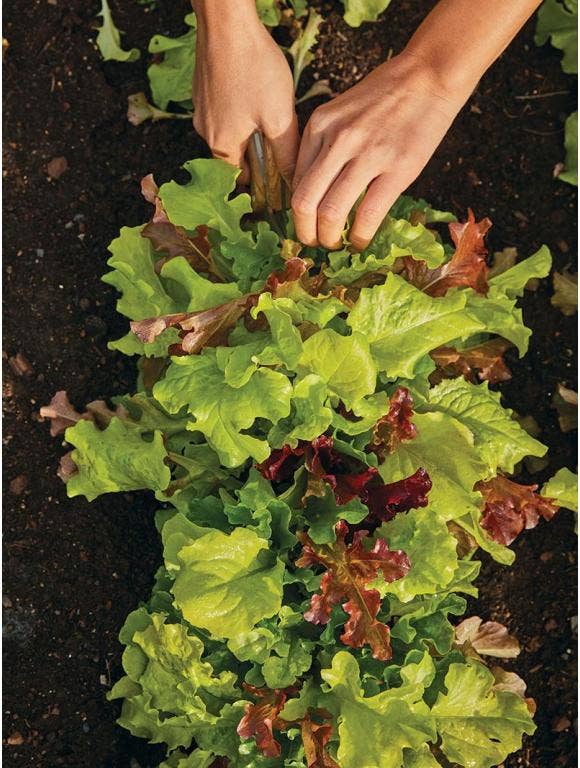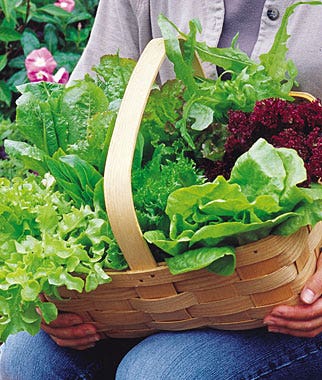
Can I Grow Lettuce?
Gardeners can select from a large variety of lettucesthat are easy to grow, highly productive in limited space, and virtually pest and disease free. Lettuce is definitely one of the more ""care-free"" crops.
For maximum lettuce production, it's wise to select a site where the soil drains well, yet retains some moisture. The soil should also be rich in nitrogen and potassium, The best way to accomplish this is to work in plenty of organic matter (compost, rotted manure, or leaf mold) that will loosen and enrich the soil. Strive for a pH of 6.0 to 6.8.
Most lettuce varieties mature in 45 to 55 days, allowing many gardeners to plant two or even three crops. But looseleaf and butterhead leaves can be harvested at just about any time in their development. Heading varieties take longer to mature. Romaine takes 75 to 85 days and crisphead 70 to 100 days.
By choosing the right varieties, it's possible to have lettuce in your garden throughout the growing season.
Lettuce Plant History
Lettuce, one of the oldest food plants known to man, is believed to have originated in India and Central Asia. Herodotus wrote of lettuce being served in ancient Greece, and it was a favorite vegetable in ancient Rome. In fact, the word "lettuce" is derived from the Latin root word "lac" meaning "milk," referring to the milky juice found in mature lettuce stems.
Columbus and other European explorers brought lettuce seeds to the New World. Our early colonists included lettuce in the first gardens planted in American soil. Today, lettuce is a favorite vegetable here and around the world.
Should I Plant Lettuce Seeds Or Plants?
Lettuce is so easy to grow it can be started indoors for early transplants or sown directly in the garden. In fact, doing both is recommended to get maximum production.
Start some lettuce seeds indoors in peat pots a few weeks before the last frost date in your area. Provide the seedlings with plenty of sunlight or keep them under artificial lighting until ready to move into the garden. Transplant the seedlings as soon as the soil can be worked in the spring. If a hard freeze threatens, protect the seedlings with a cloche or row cover. Reserve a number of lettuce seedlings to fill empty spaces in the garden as the season progresses.
To sow lettuce directly in the garden, simply plant the seeds about 1/4 inch deep, tamp them down, and water. It's that simple! Space the sowings according to packet directions that are based on the size of the mature lettuce. For example, a crisphead may require a square foot of garden space. As many as nine plants of a small leaf lettuce variety can grow in the same space.
Keep in mind that lettuce seeds won't germinate in soil that is 80 degrees F. or warmer, so there's no sense in sowing directly in the garden in the summer. Resort to starting heat-tolerant varieties indoors and moving the lettuce seedlings into the garden, preferably under partial shade, after they've developed a few true leaves.
How To Cultivate Lettuce Plants
Here are two cultivation tips to keep in mind:
Succession plantings
Lettuce is ideal for succession planting. Sow seeds every two weeks for production throughout the season, starting with early lettuce varieties, using heat-tolerant varieties as your main crop, and then switching to fall crops late in the summer. Or, if you prefer, use lettuce in successions with other crops. For example, plant lettuce in the spring, followed by bush beans in the summer, followed by lettuce again in the fall.
Watering
The key to lettuce production is supplying moderate but almost constant water, especially during hot weather. Unless there is regular rainfall, lettuce must be watered deeply at least once a week- more frequently during periods of drought. Mulch with a layer of compost or clean straw to help the soil retain moisture. A drip-irrigation system is ideal.
Lettuce Growing Tips
To improve overall lettuce production, consider using the following four techniques.
Raised Beds
To maximize lettuce production, plant seeds in raised beds. The raised beds warm up faster than the surrounding ground. You should be able to get an earlier start in the spring and a later crop in the fall.
Living mulch
To make the most of limited garden space, plant lettuce around taller plants like broccoli, Brussels sprouts, peppers, and eggplants. The lettuce helps its neighbor by keeping the surrounding soil moist and cool and keeping weeds shaded out. As the taller plants grow, they provide needed shade for the lettuce as the days get warmer.
Tucking
You can also start lettuce seedlings indoors for filling vacancies in the garden in late spring and again in early fall as other crops are harvested. Simply 'tuck' a seedling in the vacant spot to keep every inch of garden space in constant production.
Ornamental Use
Many varieties of lettuce are welcome additions to ornamental beds. For example, 'Mighty Red Oak,' 'Sweet Red,'and 'Sierra Blush' can easily fill gaps in flowerbeds, adding splashes of red where needed.
Lettuce Insects & Diseases
Lettuce is generally disease and pest free, but you should still be vigilant.
Cutworms and slugs are the most bothersome pests. Use a paper collar around young lettuce seedlings to keep the ravenous caterpillars at bay. Slugs are tougher to control. Sprinkle wood ashes or diatomaceous earth over the soil around the plants to discourage the nasty mollusks. Be sure to reapply after each rainfall.
A major threat is lettuce rot which first attacks the lower leaves in contact with the soil and then spreads throughout the plant. The best way to prevent fungal and bacterial diseases is to rotate crops. Don't plant lettuce in the same bed two years in a row.
Lettuce Harvest Tips
Lettuce can be harvested any time after true leaves form. For the best quality, better to pick early than late as lettuce allowed to grow too long may be bitter and tough.
To harvest crisphead, Batavia, and romaine varieties, cut the plant right at the soil line when mature, if you prefer to harvest full heads. You can do the same with butterhead and looseleaf lettuce, but I prefer to harvest only the outer leaves as needed. This keeps the plants in production longer. Try to harvest in the morning when the leaves are crisp, sweet, and full of moisture.
When the crown of a lettuce plant elongates, it's about to bolt to produce seed and the plant has passed its prime. Yank the lettuce plant out, toss it on the compost pile, and replant the space with another crop like bush beans, or with another lettuce seedling.
Lettuce Recipes & Storage
Primarily water, lettuce does not store well. For the best quality and flavor, use homegrown lettuce soon after harvest. This is particularly true for many of the looseleaf varieties, which wilt readily.
Combine crisp, crunchy lettuce varieties with soft, buttery-smooth types. For example, a blend of 'Little Caesar,' 'Burpee Bibb', 'Mighty Red Oak Leaf,' and 'Crispy Frills' makes a fine tossed salad with a variety of colors, shapes, and textures. Try different blends until you find the ones that most delight your palate.
See all our Lettuce



